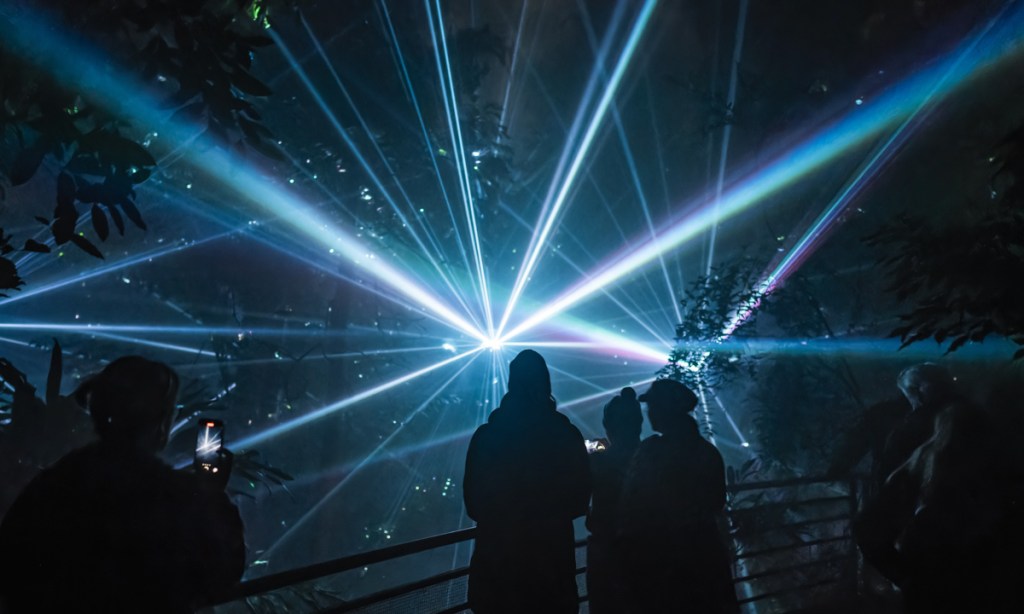Play with light, interactivity and sound at artist Tim Gruchy’s installation for Illuminate 2024.
Tim Gruchy takes Illuminate by STORM
Tim Gruchy is showcasing his work STORM at this year’s Illuminate Adelaide from July 5 to July 21.
The installation monitors interactors through a camera that tracks movements and sounds.
“It’s not just responding to what’s happening immediately, because it’s gathering information,” Tim says.
“It accrues energy in the space. So, if a whole bunch of school kids, for example, are making a whole lot of racket it starts to add up that whole lot of racket – I’ll call it sonic energy. [STORM] then starts to behave and work in different ways.”
Tim says that the more you interact with the work, “the more things start to happen”.
“So, essentially, if you stand in front of it and don’t move not a lot happens a little bit happens, [but] not a lot. The more you move around [and] make sounds, the more things happen, and the work slowly accrues that and goes into other levels,” he says.
“[It’s] the idea that the more we engage with the world, the more we get that from the world.”
Tim says the installation has a “huge” dynamic range: “The more you put into it, the more you get out of it.
“If I perform in front of STORM, because I’ve made it and know what it does, I can generally get more out of it.”

Tim standing by STORM from a previous showing
STORM has been in the works for about 10 years now and is currently at “version two”.
“It’s a work that has been around for a long time, but it has still got currency,” Tim says.
“It just keeps evolving, rather than being a finished work.”
He says STORM stands for Stochastic Translator of Resonant Morphology.
“It’s this idea that medical science is resolving the body at higher and higher resolutions,” he says.
“What I undertook to do [with the installation] was develop a set of seeds, I’ll call them, each of which has a pertinence or sort of stylistic relationship to different medical imaging technologies.”
He says he has added more scenes in version two of STORM.
“Each of the different scenes, centrally and stylistically, has a relationship to different medical imaging technologies. These evolve over time and get more sophisticated.
“A very, very long time ago in the ’70s I was the audiovisual officer in the anatomy department at Queensland University, at a time when electron microscopes, other forms of micrography and types of medical imagining were just starting.
“That opened my eyes [at] a very early stage in my life to the possibilities [of] medical imaging. So, essentially, what I’ve tried to do is create an artwork that simulates [this], because [STORM] is an artwork, not science. It’s just based on these ideas that I’m discussing.”

Illuminate Adelaide Resonate 2023. This picture: Tyr Liang Xplorer Studio
Tim says he has been interested in light, sound and interactivity from an early age.
“What I’ve done for nearly 50 years is explore the creative use of emerging technologies within this context,” he says.
Tim says his works “draw” from literature and STORM, in particular, is inspired by hard science fiction.
“I’m a firm believer in the reasonably well-accepted notion that science fiction informs the future,” he says. “Science fiction writers dream up ideas that engineers and scientists then realise.”
Tim says STORM plays with concepts like “the human transition forward from its current biological form” from Australian author Greg Egan’s 1994 sci-fi novel Permutation City.
Tim says he hopes his installation gets people thinking about the concepts he’s playing with.
“But to be perfectly honest, I’m just happy if people engage with it and have an enjoyable experience,” he says.
“It’s not just about looking and listening [but] it’s about the experience and that’s where all those dynamic issues come in.
“If I can create a work that people from three to 93-years-old can actually engage with and enjoy, well, then I figure I’m doing a good thing.”
Tim says, while art is crucial to the world, to expect that it can change the world is “expecting too much”.
“I just like to see people enjoying themselves, you know, and that’s where Illuminate is terrific because it provides a whole lot of platforms that actually engage the public in different ways,” he says.
Tim says STORM is “probably” his most popular work.
“Version two has been shown in various festivals in Australia but only once in Adelaide,” he says.
STORM is part of Illuminate Adelaide’s free City Lights program and is showing from July 5 to July 21.
The installation is located at Flinders University City Campus, Festival Plaza.




